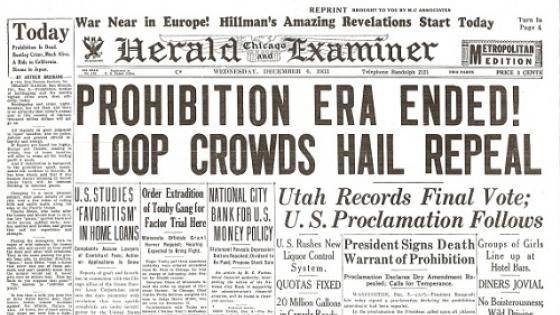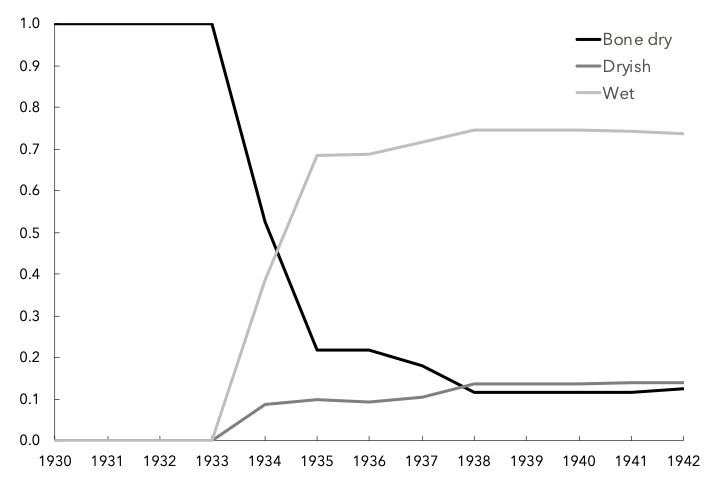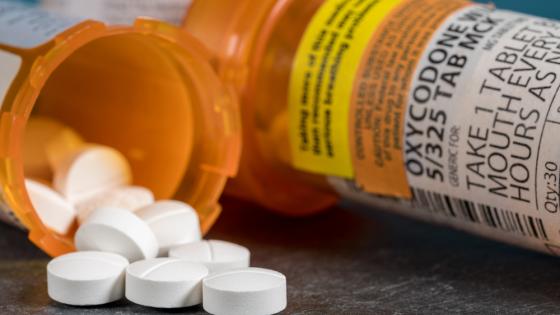The year 2020 marked the centenary of the federal prohibition on the production, sale, and transportation of alcohol in the US (Neklason 2020). In the years since, there has been broad interest in understanding why the Prohibition movement spread in the years before 1920, how federal Prohibition was enforced in the years after 1920, and why it was so quickly repealed, in 1933 (Rorabaugh 2018).
However, social scientists should be interested in this peculiar episode for more than mere antiquarianism. Federal Prohibition was an immense and unprecedented intervention into the economic and social fabric of the US (Kyvig 2000, Okrent 2010), but there is surprisingly little research in quantitatively assessing its outcomes. Given its scope, such an assessment could also inform policy making in the present, particularly as it relates to the currently evolving legalisation of cannabis and the potential de jure decriminalisation – but de facto legalisation — of even ‘harder’ drugs (Selsky 2021).
Prohibition in the collective imagination versus reality
A brief review of the popular history of Prohibition in the US suggests that it failed to subdue, and perhaps even encouraged, the long-standing alcoholic proclivities of many Americans. This was the age of cocktails, jazz, and speakeasies, after all. However, in reality Prohibition had its most significant effects on the price — but not necessarily the availability — of alcohol (Cook 2007).
As with anything that effectively functions as a large tax on a product, there was a sizeable impact on consumption due to Prohibition. Contrary to public opinion, total alcohol consumption per person fell by 63% from 1910 (the high-water mark of pre-Prohibition drinking activity) to 1934 (the first full year of repeal). And while illegal sources of alcohol were indeed available prior to and even after 1934, it took until 1973 for apparent per-capita alcohol consumption to recover from the shock of Prohibition (as seen in Figure 1).
Figure 1 Apparent per-capita alcohol consumption, 1910–2010
Note: The figure depicts apparent per-capita alcohol consumption, derived from alcoholic-beverage sales data and measured in gallons of pure ethanol.
Source: LaVallee and Yi (2011).
Another important aspect of Prohibition was how it was ended. Specifically, the process of repeal was not uniform, with national restrictions on alcohol ‘turning on’ precisely in 1920 and ‘turning off’ precisely in 1933. The chief compromise for achieving its ratification was allowing local communities to determine liquor laws appropriate to local conditions. This not only explains why approximately 10% of all US counties still prohibit the sale of alcohol, but also provides useful variation for conducting statistical analysis on the effects of Prohibition’s repeal (as seen in Figure 2).
Figure 2 US counties by Prohibition status, 1930–1942
Note: The figure uses all US counties (n = 3,043). ‘Bone dry’ are dry counties surrounded by other dry counties. ‘Dryish’ counties are dry counties with at least one wet neighbour. ‘Wet’ counties are counties that allow alcohol sales within their borders. The figure treats every county as bone dry prior to 1934.
In our work, we rely on the sharpest possible distinction in Prohibition status: dry versus wet. That is, we seek to compare outcomes for those cities/counties for which no sales of alcohol are permitted (dry) to those for which at least some sales are permitted (wet). We also make the critical distinction between those cities/counties which are dry and have no wet neighbours (bone dry) versus those cities/counties which are dry and have at least one wet neighbour (dryish). We thereby decompose all dry cities/counties into either bone dry or dryish cities/counties.
Infant mortality and the repeal of federal Prohibition
In Jacks et al. (2021), we explore the link between infant mortality and repeal, from 1933 to 1939. Infant mortality is not only a key determinant of life expectancy, but also a rough indicator of population health, making it an obvious starting point for research focused on the public-health effects of repeal.
In particular, we ask what effect a county’s choice regarding their Prohibition status after repeal had on infant mortality within its borders, and whether that choice had an impact on infant mortality across its borders and into neighbouring counties.
We find that repeal was associated with equivalent and significant increases in infant mortality in both counties that chose to allow for the sale of alcohol (wet counties) and in neighbouring counties that chose not to (dryish counties), suggesting a large role for cross-border policy spillovers. In other words, some people in dry counties found the temptation of alcohol just across the border too tempting to resist.
Cumulatively, we estimate that 4,493 annual excess infant deaths could be attributed to the repeal of federal Prohibition. We have some evidence that this was due to an increase in maternal alcohol consumption by problem drinkers during pregnancy, but other mechanisms are possible.
Urban mortality and the repeal of federal Prohibition
A frequent retort to the results above on infant mortality relates to popular impressions of the Prohibition period, namely that it saw a massive rise in organized crime and an attendant increase in gangland violence directly attributable to Prohibition. In Jacks et al. (2020), we address this issue head-on by assessing the effects of federal Prohibition’s repeal on multiple causes of urban mortality.
We find evidence that legalisation of alcohol sales at the city level is associated with a 14.7% decrease in homicide rates and a 10.1% decrease in mortality rates associated with other accidents (importantly, this category includes accidental poisonings). In understanding these results, there are various hypotheses that run counter to the idea that the repeal of Prohibition would be associated with reductions in both homicides and other accidents.
For instance, one reasonable hypothesis is that repeal would be associated with an increase in other accidents due to drunken misadventure. But another equally reasonable hypothesis is that repeal would also be associated with a decrease in accidental poisonings due to renewed access to legal supplies of unadulterated alcohol. Thus, it is a fundamentally empirical question as to which direction such countervailing forces work themselves out.
When we combine our estimates with the timing of these transitions by cumulating homicides and other accidents by wet status, a back-of-the-envelope calculation suggests an annual reduction of 3,418 urban deaths (565 fewer homicides plus 2,853 fewer other accidents) that could be attributed to the repeal of federal Prohibition.
Prohibition’s repeal in the balance
For whatever benefits the repeal of federal Prohibition conferred in terms of consumer welfare, diminished expenditure on law enforcement, and freedom of choice, it also came at the cost of increasing infant mortality in both dryish and wet counties. And this increase in infant mortality was not fully offset by equivalent declines in non-infant urban mortality. Furthermore, from the perspective of assigning the value of a statistical life, any consideration of balancing the respective rates of mortality should put more weight on averting infant — as opposed to adult — deaths.
Naturally, there were other associated components of repeal that remain unexplored and should be added to any reckoning with Prohibition’s legacy. However, the cumulative results suggest that, on net, repeal had negative effects on public health and mortality in the US. This is one history lesson well worth considering as debates over the legalisation of illicit substances remerge.
References
Cook, P (2007), Paying the Tab: The Costs and Benefits of Alcohol Control, Princeton University Press.
Jacks, D S, K Pendakur and H Shigeoka (2020), “Urban Mortality and the Repeal of Federal Prohibition”, CEPR Discussion Paper 15510.
Jacks, D S, K Pendakur and H Shigeoka (2021), “Infant Mortality and the Repeal of Federal Prohibition”, Economic Journal, forthcoming.
Kyvig, D E (2000), Repealing National Prohibition, Ashland, OH: Kent State University Press.
LaVallee, R A and H Yi (2011), “Apparent Per Capita Alcohol Consumption: National, State, and Regional Trends, 1977-2009”, NIAAA Surveillance Report 92.
Neklason, A (2020), “Prohibition Was a Failed Experiment in Moral Governance”, The Atlantic, 16 January.
Okrent, D (2010), Last Call: The Rise and Fall of Prohibition, New York: Scribner.
Rorabaugh, W J (2018), Prohibition: A Concise History, Oxford: Oxford University Press.
Selsky, A (2021), “Oregon 1st State to Decriminalize Possession of Hard Drugs”, PBS NewsHour, 1 February.








